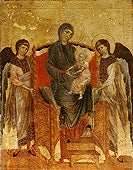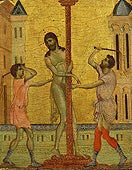Cimabue and Early Italian Devotional Painting
October 3 through December 31, 2006
|
 |
|
 |
|
|
|
|
| |
Cenni di Pepo (c. 1240–c. 1302), known as Cimabue, The Virgin and Child Enthroned with Two Angels, c. 1280, tempera on poplar panel, National Gallery, London |
|
Cimabue, The Flagellation of Christ, c. 1280, tempera on poplar panel, The Frick Collection,
Photo credit: Michael Bodycomb
|
|
|
|
|
The most celebrated Florentine artist of his generation, Cimabue
(c. 1240 – 1302)
won acclaim for his achievements in naturalistic representation and emotional
expression in monumental altarpieces, frescoes, and mosaics. In 1950 The Frick
Collection acquired an extremely rare small-scale painting attributed to Cimabue,
The Flagellation of Christ. Scholars immediately recognized the work’s beauty and
importance but debated whether it was in fact a work by Cimabue or by his Sienese
counterpart, Duccio di Buoninsegna (c. 1255–1319).
In 2000 another small painting by Cimabue, The Virgin and Child Enthroned with
Two Angels, was discovered in a private collection in Britain. Scholars attributed
this previously unknown work to Cimabue based on stylistic comparisons to one of
his celebrated altarpieces, the Virgin and Child Enthroned with Angels (Musée du
Louvre, Paris). Studies further revealed that The Virgin and Child Enthroned, now
in the collection of the National Gallery, London, and the Frick Flagellation once
formed part of the same larger work, possibly a small altarpiece, or a diptych or
triptych used for prayer. At an unknown date, this work was cut apart, and its individual
scenes entered the art market as independent panels.
The Frick and National Gallery paintings are reunited here for the first time in the
United States and presented along with other examples of devotional art from early
Renaissance Italy. A triptych painted by the anonymous Florentine artist known as
the Magdalen Master, a contemporary of Cimabue’s, and a diptych by Pacino di
Bonaguida, a contemporary of Giotto’s (traditionally considered Cimabue’s pupil),
represent two typical forms of multipanel ensembles created by early Italian artists.
An illuminated picture-book manuscript by Pacino and a verre églomisé (painted
and gilded glass) reliquary diptych illustrate the variety of media used to create
objects for personal prayer. Like the ensemble that once included the two Cimabue
panels, these works feature multiple scenes from the Life of Christ, offering viewers
gleaming, jewel-like windows into sacred history.
Cimabue and Early Italian Devotional Painting was coordinated for The Frick Collection by Holly Flora, Curator, Museum of Biblical Art, in conjunction with the Frick’s Associate Curator Denise Allen. The exhibition has been generously underwritten by Jon and Barbara Landau. Additional support has been provided by The Council of The Frick Collection and The Helen Clay Frick Foundation. The accompanying publication is made possible, in part, by Lawrence and Julie Salander.
|


